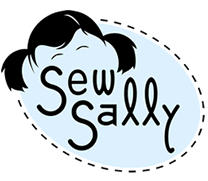

I have a good sized collection of things that cut and I love them all! By my cutting table, I have the rotary cutters and large scissors and by my machines, I have the small scissors. As you can see by all the blue ribbons, I label my scissors, etc as MINE with the same blue ribbon. That way, when I travel to the super fun Sisters Gig and other places where someone else might have the same tool, I know which one is mine!
The scissors I use are all Ginghers. Back in the day, they were made in Germany and Italy, and were stamped with that information. I've heard that the company has been recently bought by Fiskars and the scissors are now being made in Mexico. Mine are all old enough that I haven't had any experience with "new" ones to know if quality has been compromised. I will say (and I tell this to all my students) that although a pair of Gingher shears cost twice as much as Fiskars, they will last 10 times longer. My 7" shears were a gift when I turned 13, I've never had to have them sharpened, and they still cut fabric like it's butter. My 8" shears were a Christmas gift a few years ago and are noticibily sharper, and can cut through much thicker layers with ease. Since my hands are quite small, I really like owning both pairs. That way I only tire my hands with the big ones when I really need to.
But why tire the hands and induce carpal tunnal when there is the good friend the rotary cutter? I also have an assortment of those - one just for cutting fabric, one for cutting paper, and one with a "pinking" blade. I don't really recommend the pinking blade, because I find it really damages my self-healing mat when I try to cut curves with it. When the blade gets dull on my regular fabric cutter, I switch the blade to the paper cutter, saving on the cost of replacement blades. In addition to my 45mm rotary cutters, I also have the 18mm cutter, which is great for cutting curves. It handles better, twisting and curving around garment patterns (think armholes and neckholes) without marring the mat or skipping over fibers.
In addition to a rotary cutter, you also have to invest in a good self-healing mat and some clear rulers. The biggest issue I find with the mats is storage. Unless you have a cutting table where the mat can always lie flat, I recommend buying a medium size mat (18"x24"). That way it can easily be tucked behind a bookshelf when it isn't being used. If they aren't stored totally flat, they buckle and warp and can't be used.
Happy Sewing!




3 comments:
I'm chiming in with another note of caution on the self-healing mats: keep them away from movers! I got a rather nice one, 6 months before a move. We let the movers pack up everything. They put it in the bottom of a box that was too large for it, and then weighed it down with all my other crafty stuff, so it got all curled on one end. Two and a half years later, it's still rolled up at that end. Bummerz. Thanks for the peek into your workplace, Sally! I love it! Can't wait to see more.
i love your wall of cutting things, all organized and bright and cheery. and thansk for the tips ~ someday i['ll ahve my own craft room & will put them to good use.
Is it hard cutting curves with a rotary cutter? does the 18mm do well when cutting multiple layers? I'm unsure what size to get...should a ruler be used when cutting around curves of the pattern/fabric or just freehand?
Post a Comment